Criminalistics Chapter 8
1/26
Earn XP
Description and Tags
The Microscope
Name | Mastery | Learn | Test | Matching | Spaced |
|---|
No study sessions yet.
27 Terms
Introduction Part 1
A microscope is an optical instrument that uses a lens or a combination of lenses to magnify and resolve the fine details of an object.
The earliest methods for examining physical evidence relied solely on the microscope.
Introduction Part 2
Virtual image: The magnified image seen by looking through a lens
Real image: An image viewed directly
The object to be magnified is placed under the lower (objective) lens, and viewed through the
upper lens (eyepiece).
Various types of microscopes are used to analyze forensic specimens.
Figure 8-2 The Principle of the Compound Microscope
The passage of light through two lenses forms the virtual image of the object seen by the eye.
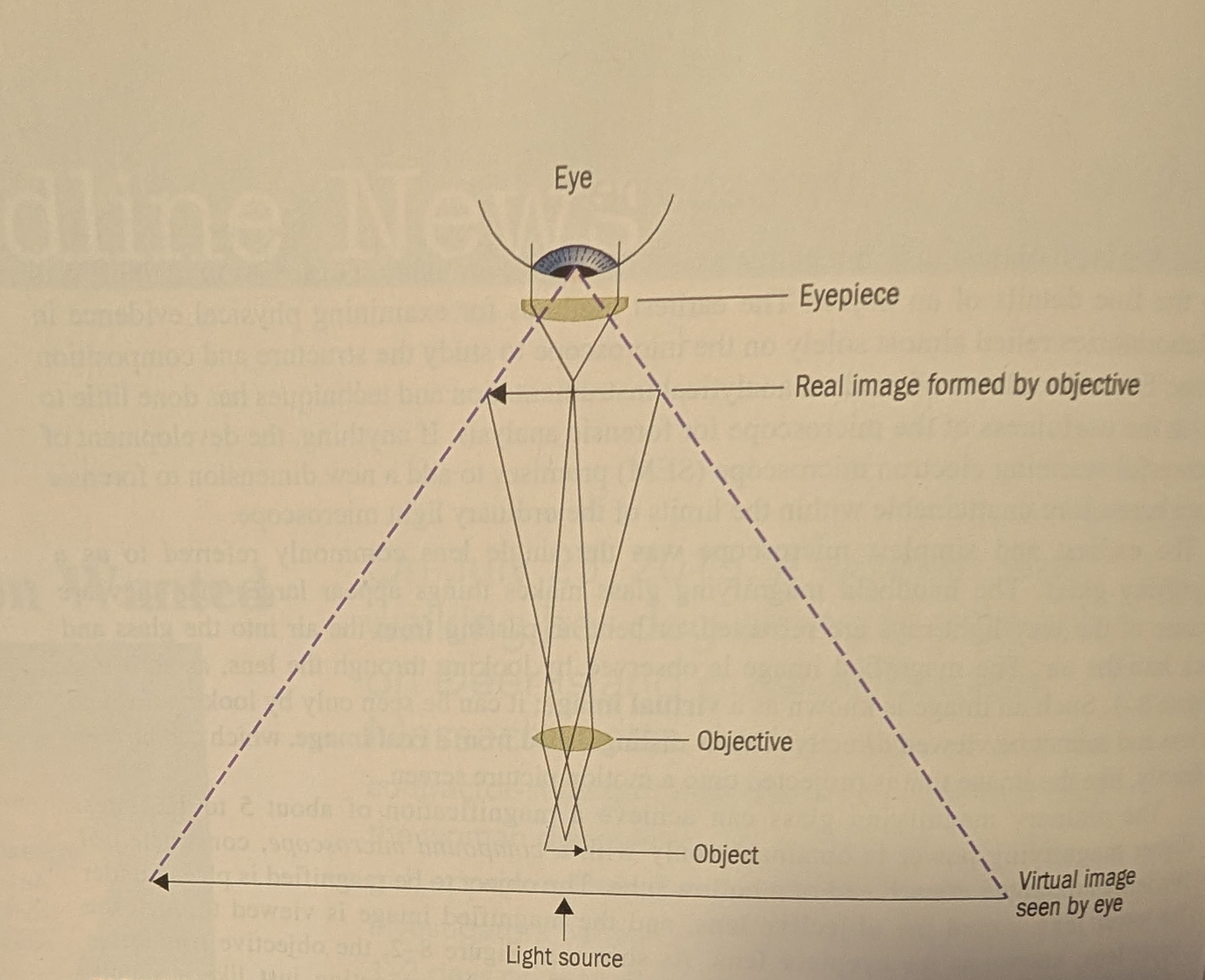
The Compound Microscope Part 1
In the basic compound microscope, the object to be magnified is placed under the lower lens (objective lens) and the magnified image is viewed through the upper lens (eyepiece lens).
The magnification of the image can be calculated by multiplying the magnifying power of the objective lens times the magnifying power of the eyepiece lens.
The Compound Microscope Part 2
The microscope is composed of a mechanical system which supports the microscope, and an optical system which illuminates the object under investigation and passes light through a series of lenses to form an image of the specimen.
Figure 8-4: Optics of the Compound Microscope
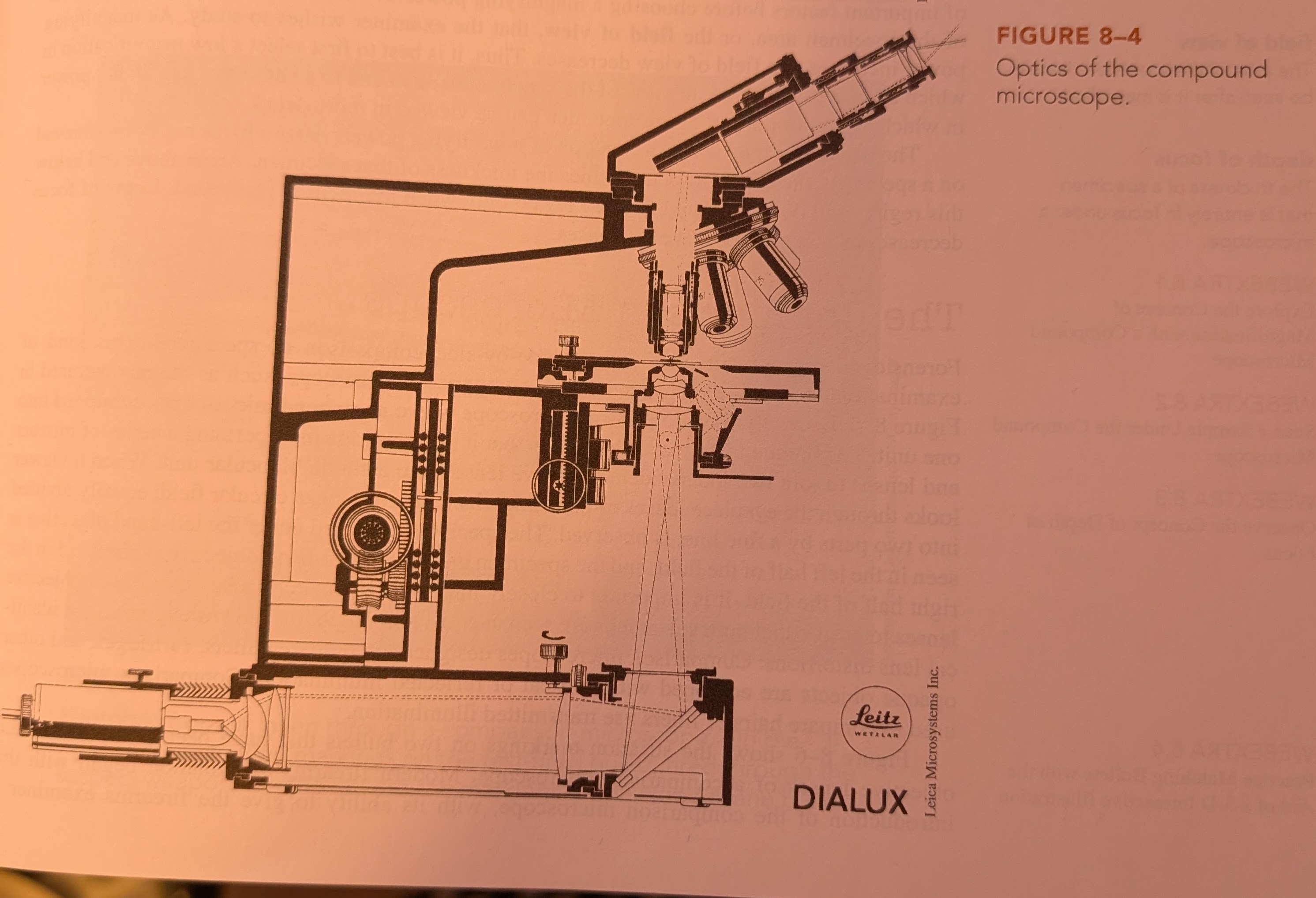
The Compound Microscope Part 3
The Mechanical System
-Base
The support
-Arm
The C-shaped upright structure
-Stage
The plate on which the specimens are placed
The Compound Microscope Part 4
-Body Tube
The hollow tube on which the objectives and eyepiece lenses are mounted
-Coarse Adjustment
The knob used to focus the microscope lenses by moving the body tube
-Fine Adjustment
The knob also used to focus the lenses by moving the body tube, but by a much smaller magnitude
The Compound Microscope Part 5
The Optical System
-Illuminator
Artificial light, usually supplied by a light bulb, to illuminate the specimen
Transmitted Illumination
-when the light is directed up through the specimen from the base
Vertical/Reflected Illumination
-when the light comes from above and reflects off the specimen
The Compound Microscope Part 6
-Condenser
Lens system under the microscope stage that focuses light onto the specimen
-Objective Lens
The lens closest to the specimen
Usually several objectives are mounted on a revolving nosepiece
The Compound Microscope Part 7
Parfocal
-when the microscope is focused with one objective in place, another objective can
be rotated into place and the specimen remains very nearly in correct focus
The Compound Microscope Part 8
-Eyepiece or Ocular Lens
The lens closest to the eye
Monocular-A microscope having only one eyepiece
Binocular-A microscope having two eyepieces
The Comparison Microscope Part 1
The comparison microscope consists of two independent objective lenses joined together by an optical bridge to a common eyepiece lens.
When a viewer looks through the eyepiece lens of the comparison microscope, the objects under investigation are observed side-by-side in a circular field that is equally divided into two parts.
The Comparison Microscope Part 2
Modern firearms examination began with the introduction of the comparison microscope, with
its ability to give the firearms examiner a side-by-side magnified view of bullets.
Figure 8–5:
The Comparison Microscope—Two Independent Objective Lenses Joined Together by an Optical Bridge
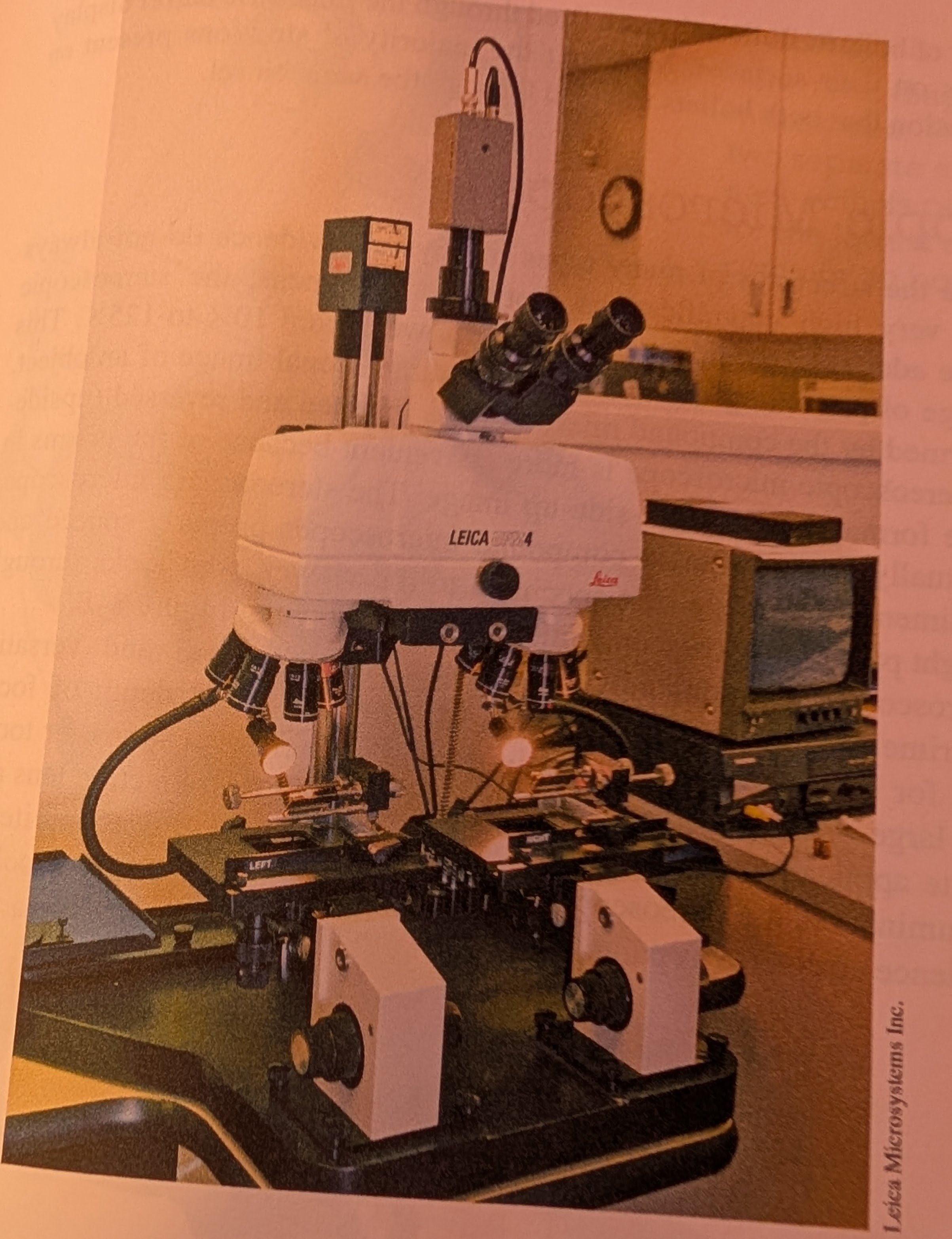
The Stereoscopic Microscope
The stereoscopic microscope is actually two monocular compound microscopes properly spaced and aligned to present a three-dimensional image of a specimen to the viewer, who looks through both eyepiece lenses.
-Particularly useful for evidence not requiring very high magnification (10x−125x)
-Large working distance makes it quite applicable for examining big, bulky items
Figure 8–8: Schematic Diagram of a Stereoscopic Microscope
This microscope is actually two separate monocular microscopes, each with its own set of lenses except for the lowest objective lens, which is common to both microscopes.
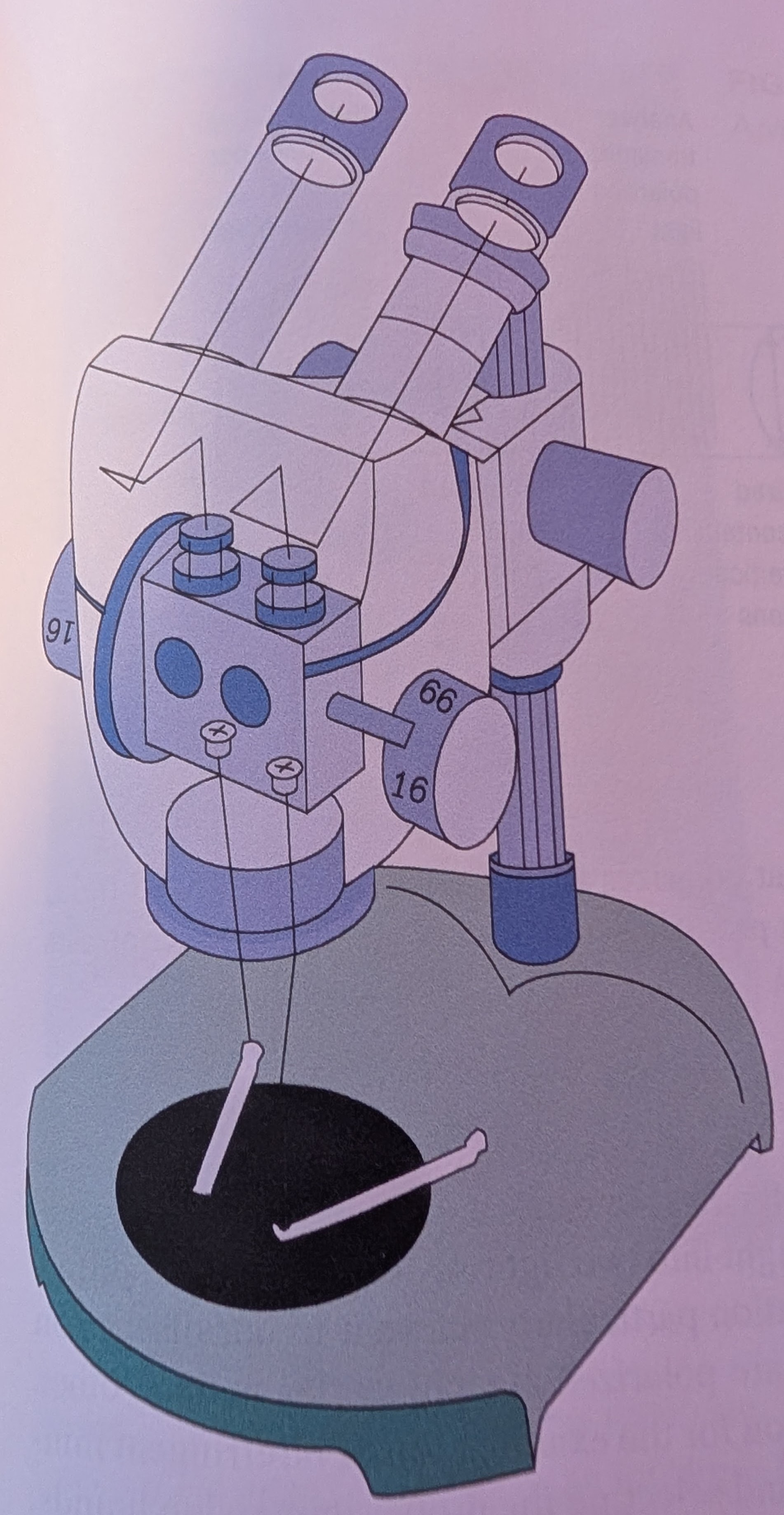
Polarizing Microscopy Part 1
Light that is confined to a single plane of vibration is said to be
plane-polarized.
The examination of the interaction of plane-polarized light with matter is made possible with
the polarizing microscope.
Polarizing Microscopy Part 2
Polarizing microscopy has found wide applications for the study of birefringent materials; materials that split a beam of light in two, each with its own refractive index value.
-Determining these refractive index data provides information that helps to identify minerals present in a soil sample or the identity of a man-made fiber.
The Microspectrophotometer
The microspectrophotometer is a spectrophotometer coupled with a light microscope.
The examiner studying a specimen under a microscope can simultaneously obtain the visible absorption spectrum or IR spectrum of the material being observed.
This instrument is especially useful in the examination of trace evidence, paint, fiber, and ink evidence.
The Scanning Electron Microscope Part 1
The scanning electron microscope (SEM) bombards a specimen with a beam of electrons
instead of light to produce a highly magnified image from 100x to 100,0000x.
Its depth of focus is some 300 times better than optical systems at similar magnification.
The Scanning Electron Microscope Part 2
Bombarding the specimen’s surface with electrons normally produces X-ray emissions that can be used to characterize elements present in the material under investigation.
A Schematic Diagram of a Scanning Electron Microscope Displaying the Image of a Gunshot Residue Particle
Simultaneously, an X-ray analyzer detects and displays X-ray emissions from the elements lead (Pb), antimony (Sb), and barium (Ba) present in the particle.
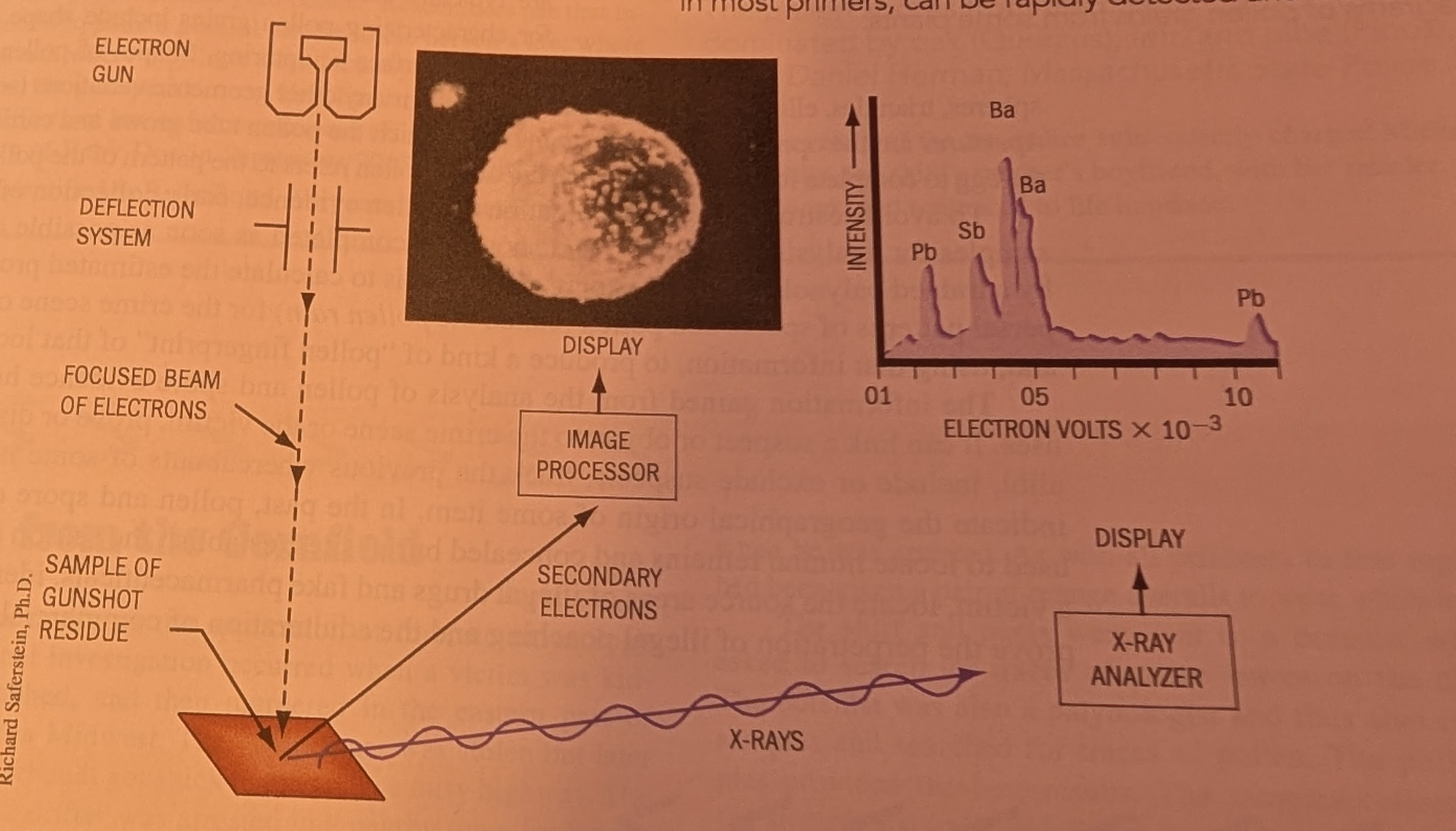
Primer Residue on Hands Part 1
The firing of a weapon propels residues toward the target, but also blows gunpowder and primer
residues back toward the shooter.
-Traces of these residues are often deposited on the shooter’s firing hand
-Detecting these residues can provide valuable information as to whether or not an individual has recently fired a weapon
Primer Residue on Hands Part 2
With the aid of a scanning electron microscope, examiners measure the amount of barium and
antimony on the relevant portion of the suspect’s hands, such as the thumb web, the back of the
hand, and the palm.
Examiners may use a scanning electron microscope to characterize the morphology of
particles containing these elements to determine whether or not a person has fired, handled a
weapon, or was near a discharged firearm.
Forensic Palynology Part 1
Forensic palynology involves the collection and examination of pollen and spores connected with crime scenes, illegal activities, or terrorism.
The microscope is the principal tool used in the field of forensic palynology.
Forensic Palynology Part 2
The information gained from the analysis of pollen and spore evidence has many possible uses:
-Link a suspect or object to the crime scene or the victim
-Prove or disprove a suspect’s alibi
-Include or exclude suspects
-Track the previous whereabouts of some item or suspect
-Indicate the geographical origin of some items